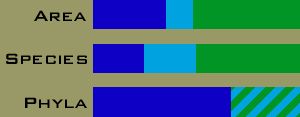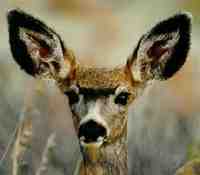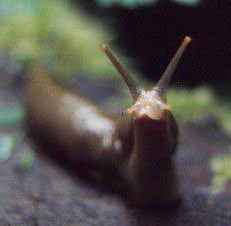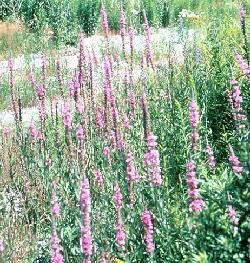|
Canadian Patterns
Canada's
land and species | Plants
| Vertebrates
Invertebrates
| Invasive | Endangered
Canada's
Land and Species
Canada has over 140 000 species,
only 70 000 of which have been identified. Half of these species are terrestrial,
a quarter freshwater and the other quarter marine. In the figure, the
terrestrial component (land) is represented by green, marine by dark blue,
and freshwater by light blue. Compared to the relative amounts of Canada's
territory that are in these three environmental types ("Area"
in the figure) ,
the marine environment has fewer species than expected, while freshwater
has more. This trend reverses itself at higher levels of classification;
two-thirds of phyla (one of the highest levels of classification) are
mostly or exclusively marine, while only a third are primarily terrestrial
or freshwater (enough phyla have enough members both on land and in freshwater
that it is difficult to assign them to one environment or the other, so
they are grouped together in the figure). The large number of phyla that
are marine isn't very surprising, given that life has existed in the oceans
far longer than it has on land. ,
the marine environment has fewer species than expected, while freshwater
has more. This trend reverses itself at higher levels of classification;
two-thirds of phyla (one of the highest levels of classification) are
mostly or exclusively marine, while only a third are primarily terrestrial
or freshwater (enough phyla have enough members both on land and in freshwater
that it is difficult to assign them to one environment or the other, so
they are grouped together in the figure). The large number of phyla that
are marine isn't very surprising, given that life has existed in the oceans
far longer than it has on land.
Within these three broad environmental
types, the proportion of species in any given group will vary widely from
group to group. For instance, although overall 25% of species are found
in freshwater systems, 80-98% of algae, 32% of bacteria, 15% of native
flowering plants and only 7% of fungi species in Canada are freshwater.
Only one to five percent of
Canadian species are endemic (i.e. are only found in Canada). Much
of this is due to the periodic glaciation that the land endures. The glaciers
force populations and species to move south or be destroyed, and the 10
000 years since the Wisconsin ice age hasn't been enough time for many
new species to arrive.
The patterns of Canadian biodiversity
follow a definite trend, largely following the increasingly hostile environment
as one heads north, and this pattern has been taken into account in the
borders and definitions of Canada's ecozones. What follows is a summary
of the patterns that different groups of organisms follow in Canada. For
more detail on the land and specific species found on it, see the Ecozones
and Canada's Species sections.
Plants
 Diversity
is in general highest to the south, and the further north one goes, the
fewer the number of species one encounters. North of the tree line, trees
species can no longer grow as full-grown trees, and if they are present
they are found in dwarf forms. Diversity
is in general highest to the south, and the further north one goes, the
fewer the number of species one encounters. North of the tree line, trees
species can no longer grow as full-grown trees, and if they are present
they are found in dwarf forms.
Patterns from west to east
depend largely on rainfall. British Columbia's coast receives so much
rainfall due to the mountains that temperate rain forests can be found
there. The plant species found on the Rocky and Coastal mountains vary
depending on the mountain face one is looking at; slopes facing south
receive much more sun than those facing north, and those facing west are
far wetter than those that face east. Continuing eastward, the plains
past the mountain ranges are too dry for most tree species, resulting
in the grasslands that are characteristic of the area. Southern Ontario's
fertile soil, high precipitation and temperate climate produces the highest
plant diversity in Canada.
Vertebrates
 Diversity
of vertebrates (fish, amphibians, reptiles, birds and mammals) decreases
towards the north. Freshwater fish species diversity fades out towards
the north, with only a fifth of freshwater fish species being found in
the Northwest Territories and Nunavut. Amphibians and reptiles have highest
diversity in southern Ontario for many of the same reasons as plants.
They lack the ability to survive in the extreme cold of Canada's north,
and most species have not yet expanded the northern extent of their ranges
back to pre-glaciation latitudes. Birds can also be found extremely far
north, although their presence varies remarkably depending upon the season.
In spring and summer northern Canada is filled with bird species, many
of whom fly south as winter approaches. Mammals are found on land and
in the water to almost the very northern tip of the continent. They are
well suited to the west and especially the western mountains, which have
a higher mammal diversity than flatter areas to the east. Diversity
of vertebrates (fish, amphibians, reptiles, birds and mammals) decreases
towards the north. Freshwater fish species diversity fades out towards
the north, with only a fifth of freshwater fish species being found in
the Northwest Territories and Nunavut. Amphibians and reptiles have highest
diversity in southern Ontario for many of the same reasons as plants.
They lack the ability to survive in the extreme cold of Canada's north,
and most species have not yet expanded the northern extent of their ranges
back to pre-glaciation latitudes. Birds can also be found extremely far
north, although their presence varies remarkably depending upon the season.
In spring and summer northern Canada is filled with bird species, many
of whom fly south as winter approaches. Mammals are found on land and
in the water to almost the very northern tip of the continent. They are
well suited to the west and especially the western mountains, which have
a higher mammal diversity than flatter areas to the east.
Invertebrates
 While
invertebrates (animals without backbones) are far more plentiful and diverse
than vertebrates, their distributions are much more poorly known. There
are many reasons for this: invertebrates tend to be small, making them
hard to find; the great number of species and their small size makes them
difficult to identify; they are not as popular as plants and vertebrates,
meaning that fewer people are likely to study them. While
invertebrates (animals without backbones) are far more plentiful and diverse
than vertebrates, their distributions are much more poorly known. There
are many reasons for this: invertebrates tend to be small, making them
hard to find; the great number of species and their small size makes them
difficult to identify; they are not as popular as plants and vertebrates,
meaning that fewer people are likely to study them.
Land invertebrates such as
insects and spiders disappear to the north, unable to deal with the cold.
Aquatic invertebrates are more plentiful in the south, but even in the
frigid arctic waters sea stars, sea urchins, and crustaceans can be found,
having found ways to adapt to the low temperatures.
Invasive
Species
 The
distribution of invasive species follows the pattern of trade and population
more than any climatic trend. Species have entered the country mainly
in cargo and ships from around the world (e.g. Dutch elm disease,
zebra mussels), as crops to be grown (most of our staple agricultural
crops), and as ornamental species (e.g.purple loosestrife). Most
invasive species into Canada came through the St. Laurence seaway, and
have spread outward from there. The
distribution of invasive species follows the pattern of trade and population
more than any climatic trend. Species have entered the country mainly
in cargo and ships from around the world (e.g. Dutch elm disease,
zebra mussels), as crops to be grown (most of our staple agricultural
crops), and as ornamental species (e.g.purple loosestrife). Most
invasive species into Canada came through the St. Laurence seaway, and
have spread outward from there.
Aquatic species, such as fish,
are usually easier to control than land-based species, and many have had
their spread limited. This isn't always the case; the sea lamprey was
accidentally introduced to the upper Great Lakes through the construction
of the Welland Canal, and zebra mussels have spread throughout the Great
Lakes and beyond. On the other hand, deliberately introduced game fish
can be found all through the country.
Some introduced species, such
as the starling, have spread to virtually anywhere they can survive. Agricultural
plants have been introduced all through the south, and in the Prairies
they have replaced most of the natural ecosystems.
Endangered
Species
 Like
invasive species, endangered species are found in areas of high population
density and intensive human activity. The Mixedwood Plains, for example,
contain much of Canada's species and population as well as, unsurprisingly,
much of its endangered species. Cities themselves take up relatively little
space when compared to the entire country, but many species are nonetheless
threatened by the sprawl, roads, and pollution that cities create. Agriculture
takes up huge tracts of land and is the main threat to the south, while
forestry is the major threat slightly to the north. Fisheries are a potential
threat anywhere they exist. Like
invasive species, endangered species are found in areas of high population
density and intensive human activity. The Mixedwood Plains, for example,
contain much of Canada's species and population as well as, unsurprisingly,
much of its endangered species. Cities themselves take up relatively little
space when compared to the entire country, but many species are nonetheless
threatened by the sprawl, roads, and pollution that cities create. Agriculture
takes up huge tracts of land and is the main threat to the south, while
forestry is the major threat slightly to the north. Fisheries are a potential
threat anywhere they exist.
 
|